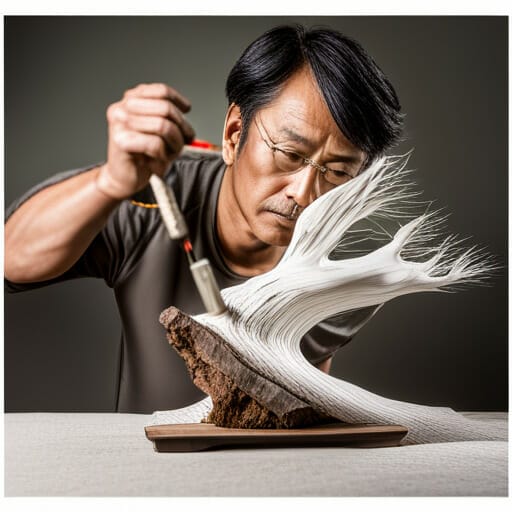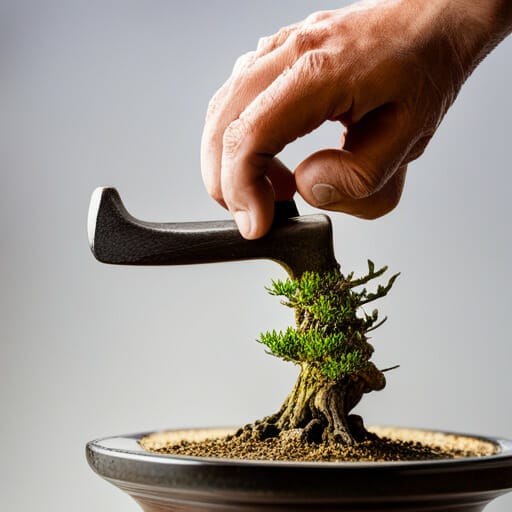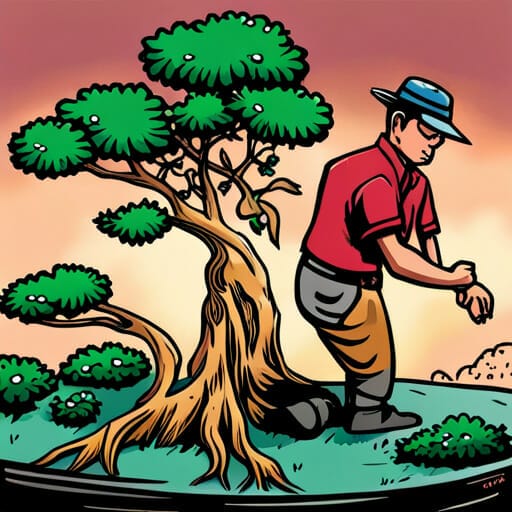Bonsai cultivation is an art form that requires patience, skill, and a deep understanding of horticulture. One of the key techniques used in bonsai cultivation is trunk chopping, a method aimed at developing thicker trunks for the trees.
This technique, although seemingly simple, holds great significance in the world of bonsai. By reducing the height of a taller tree and cutting its trunk, trunk chopping creates a strong foundation for the bonsai, enhancing its aesthetic appeal.
However, it is important to note that trunk chopping can only be performed on deciduous trees, as conifers are unable to withstand this procedure. Timing is also crucial, with late winter or early summer being the optimal periods to perform trunk chopping, depending on the tree’s dormant or active state.
After the trunk chopping process, it is crucial to allow the bonsai tree to fully recover and grow for the rest of the season.
This article will delve into the art of trunk chopping, exploring its techniques, timing considerations, and the subsequent recovery and growth of the bonsai tree.
Contents
- 1 Quick Points
- 2 What is it?
- 3 Timing and Technique
- 4 Recovery and Growth
- 5 Frequently Asked Questions
- 5.1 Can trunk chopping be done on all types of bonsai trees?
- 5.2 How long does it take for a bonsai tree to fully recover after a trunk chop?
- 5.3 Are there any risks or potential complications associated with trunk chopping?
- 5.4 Can trunk chopping be done multiple times on the same bonsai tree?
- 5.5 What are some alternatives to trunk chopping for thickening the trunk of a bonsai tree?
Quick Points
- Trunk chopping is a technique used to develop a thicker trunk on a bonsai tree.
- Trunk chopping can only be done on deciduous trees, as conifers would die from the procedure.
- Timing of trunk chopping can be done in late winter or early summer.
– After trunk chopping, cut paste can be applied to prevent further die back.
What is it?

Trunk chopping is a technique utilized in bonsai cultivation to develop a thicker trunk on deciduous trees by reducing their height and establishing a strong foundation for the bonsai, which can be done during late winter or early summer.
This technique involves cutting the trunk of a taller tree, typically with a saw, loppers, or pruners, to achieve the desired height and shape. The timing of trunk chopping is crucial, as late winter allows the tree to send out new buds after its dormancy period, while early summer takes advantage of the tree’s active state to handle large cuts without significant harm.
After the trunk chop, cut paste can be applied to prevent further die back. It is important to allow the bonsai tree to fully recover and grow out for the rest of the season after the procedure.
Trunk chopping is a valuable method for building a thick trunk from scratch in bonsai cultivation, particularly for those growing bonsai trees from seed.
Timing and Technique

Timing and technique are crucial elements in the process of sculpting the foundation of a bonsai tree, akin to a skilled painter selecting the perfect brushstroke to create a masterpiece. To ensure successful trunk chopping, it is important to consider the timing of the procedure. Late winter and early summer are the optimal times for trunk chopping. Late winter allows the tree to be dormant and promotes the growth of new buds once it wakes up. Early summer, on the other hand, is suitable as the tree is active and can handle large cuts without significant harm.
When it comes to the technique of trunk chopping, there are no strict rules. The method of cutting the trunk depends on the individual tree and the desired outcome. It can be done using a saw, loppers, or pruners. After trunk chopping, it is advisable to apply cut paste to prevent further die back.
It is essential to allow the bonsai tree to fully recover and grow for the rest of the season after a trunk chop. By understanding the timing and technique of trunk chopping, bonsai enthusiasts can successfully thicken the trunks of their trees and create stunning masterpieces.
Explore Your Understanding Of Soothing Art Of Shaping
Recovery and Growth

Recovery and growth are essential considerations after the technique of trunk chopping has been implemented in bonsai cultivation. Once a bonsai tree has undergone trunk chopping, it is crucial to allow it sufficient time to recover and grow.
This period of recovery allows the tree to heal and develop new shoots and branches. During this time, it is important to provide the necessary care and maintenance to support the tree’s growth. Adequate watering, fertilization, and protection from extreme weather conditions are vital to ensure the tree’s successful recovery.
Additionally, regular pruning and shaping are necessary to guide the tree’s growth and maintain its desired form. Patience is key during this stage, as it may take several seasons for the bonsai tree to fully recover and develop a thicker trunk.
By providing the necessary care and attention, the bonsai enthusiast can witness the tree’s gradual growth and transformation.
Frequently Asked Questions
Can trunk chopping be done on all types of bonsai trees?
Trunk chopping can only be done on deciduous trees, as conifers would die from the procedure. Therefore, trunk chopping cannot be done on all types of bonsai trees.
How long does it take for a bonsai tree to fully recover after a trunk chop?
The recovery time for a bonsai tree after a trunk chop can vary depending on factors such as the species of tree and the time of year the procedure is done. Generally, it can take several months to a year for a bonsai tree to fully recover and grow out after a trunk chop.
Are there any risks or potential complications associated with trunk chopping?
There are potential risks associated with trunk chopping in bonsai cultivation. These include the possibility of the tree not responding well to the procedure, excessive die back, and the tree being unable to recover fully.
Can trunk chopping be done multiple times on the same bonsai tree?
Trunk chopping can be done multiple times on the same bonsai tree. However, it is important to allow the tree to fully recover between each chop. Multiple chops can lead to a thicker trunk and create a more desirable bonsai shape over time.
What are some alternatives to trunk chopping for thickening the trunk of a bonsai tree?
Some alternatives to trunk chopping for thickening the trunk of a bonsai tree include ground layering, approach grafting, and using root-pruning techniques. These methods encourage the growth of new roots and promote a thicker trunk over time.




